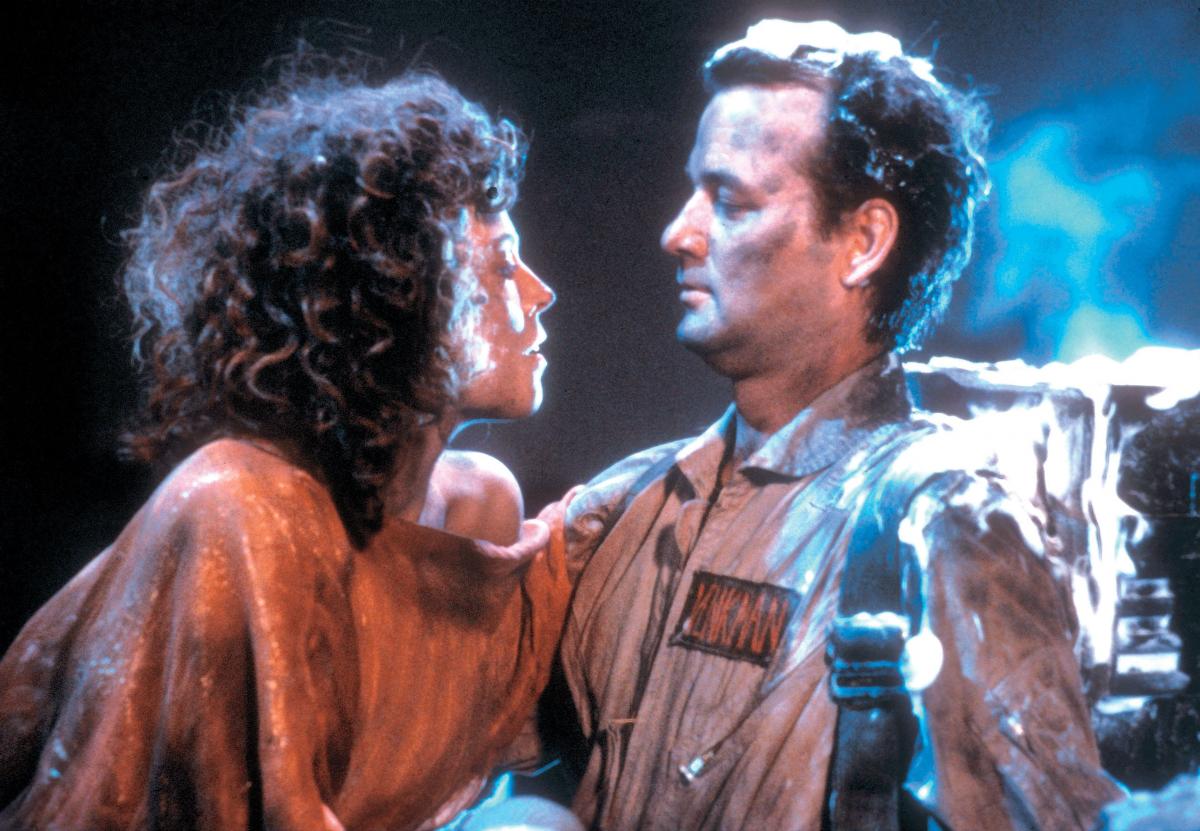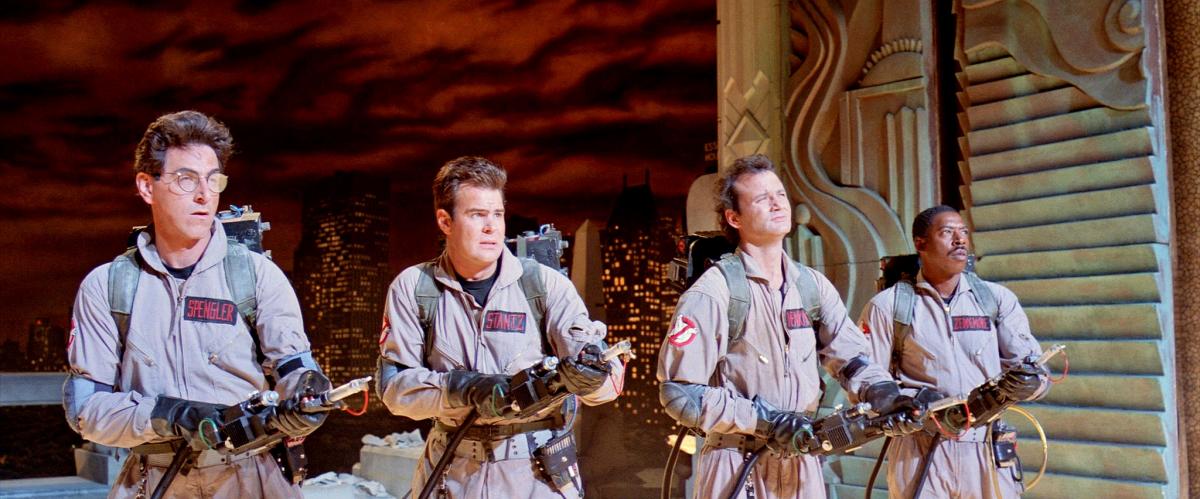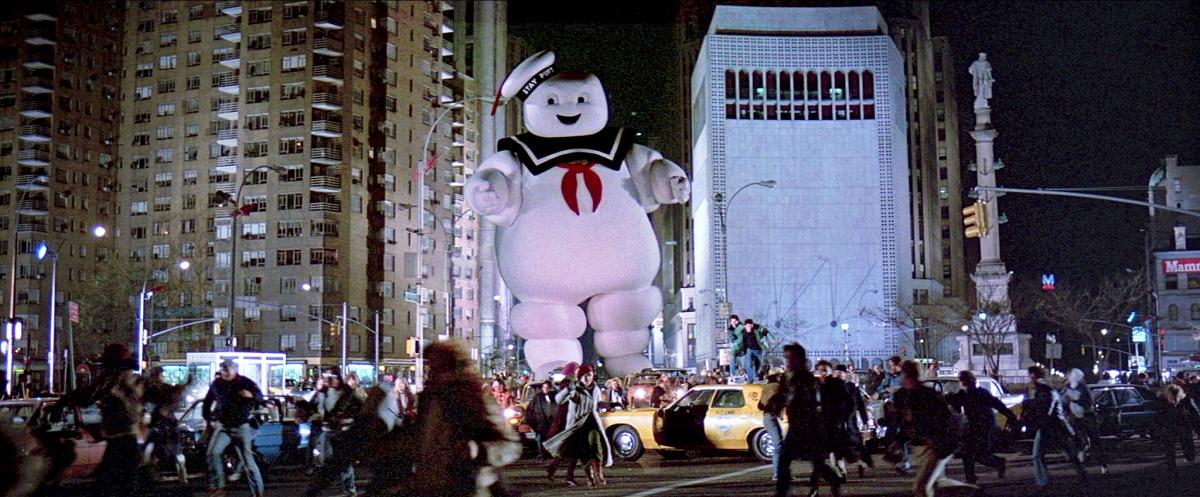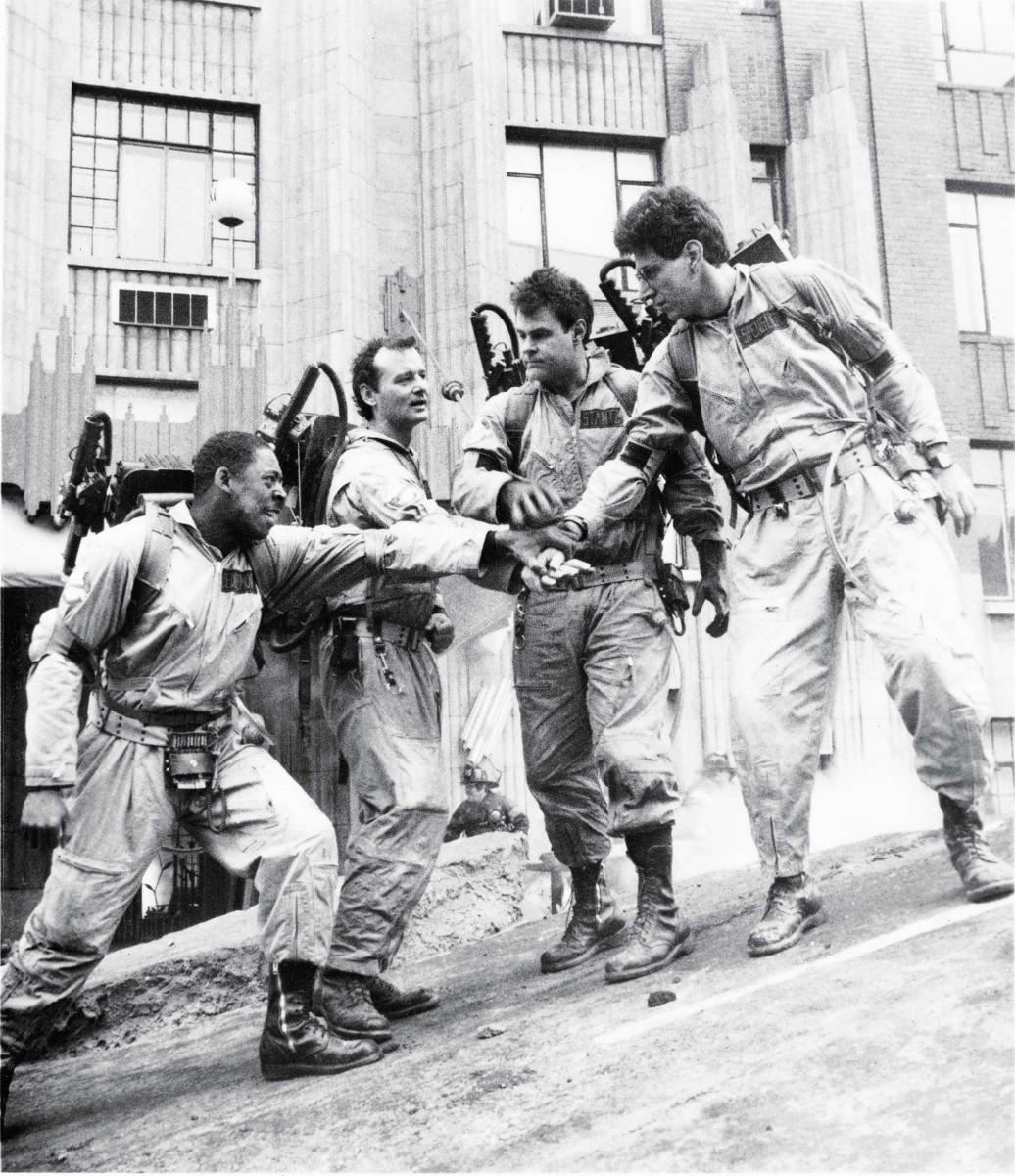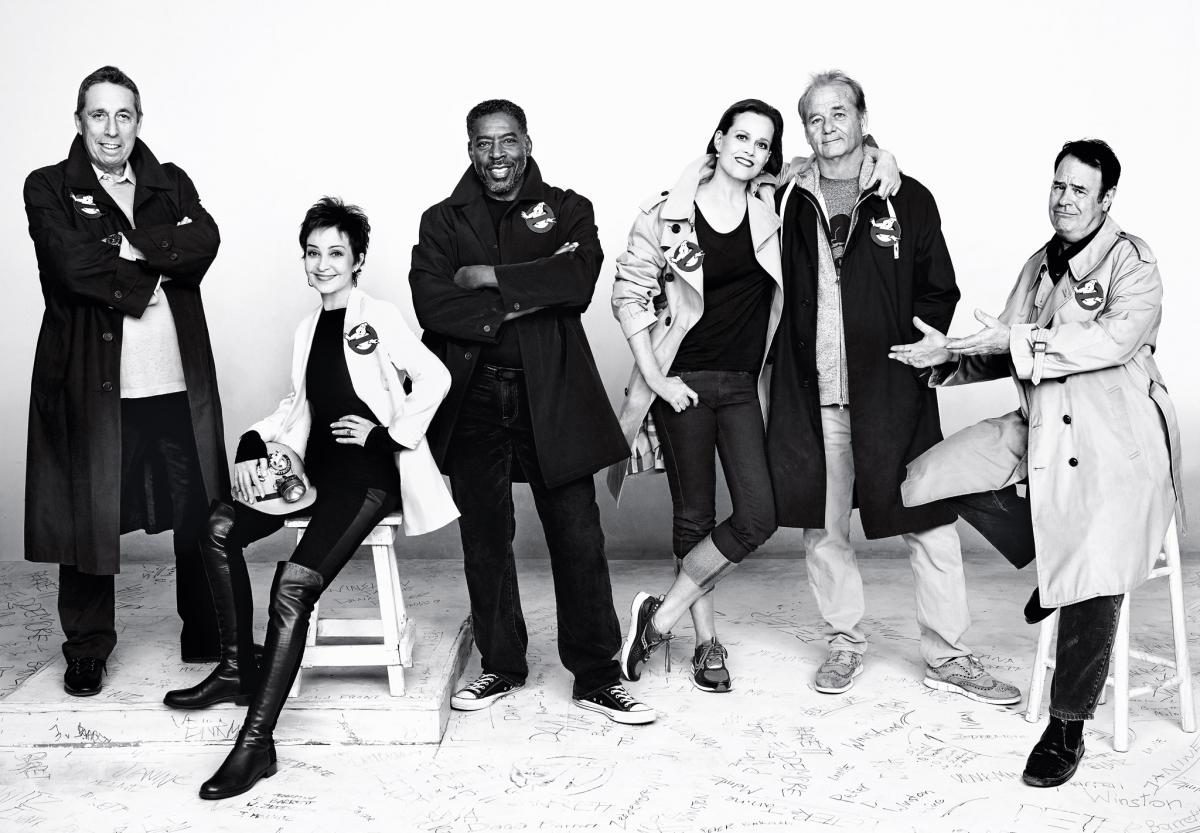
Ghostbusters cast reunited. RUVEN AFANADOR for EW
Ghostbusters:
An Oral History
Thirty years after the Ghostbusters answered the call, the cast and crew remember the making of a comedy classic.
by Jeff Labrecque
Ghostbusters cast reunited. RUVEN AFANADOR for EW
Ghostbusters:
An Oral History
Thirty years after the Ghostbusters answered the call, the cast and crew remember the making of a comedy classic.
by Jeff Labrecque
Ghostbusters has been such a huge part of our popular-culture for the last 30 years that it's easy to overlook what it represented at the time. In June 1984, when the film opened in theaters, Bill Murray was only 33 years old. Dan Aykroyd was just 31 and director Ivan Reitman was 37. Saturday Night Live had yet to celebrate its 10th anniversary, but the seeds of SNL and Second City sketch comedy had already begun to bear fruit in Hollywood, with movies like Animal House, Caddyshack, and The Blues Brothers scoring at the box office. Still, those hits were safe bets: raucous thumb-nosing comedies that mostly consisted of slobs outrunning or outsmarting Nixonian snobs.
When Columbia gave Ghostbusters a green light, though, they handed the keys to the kingdom to an irreverent creative dream team that refused to flinch or be reined in by a bigger budget. In fact, they went even further, with a B-movie plot that was both ludicrous and stuffed with images—Mr. Stay Puft? Terror dogs?—that seemed like the inhabitants of an epic ’shroom trip. But whereas Stripes and the Harold Ramis-directed Vacation appealed to the red-eyed college-kid demographic, Ghostbusters surprised everyone, including its creators, when virtually everyone, kids and grandmoms, began singing its theme song. "This movie is an exception to the general rule that big special effects can wreck a comedy," wrote Roger Ebert. "Rarely has a movie this expensive provided so many quotable lines."
Ghostbusters wasn't as massive as Star Wars at the box office, perhaps, but it represented something just as seismic by validating the new craft of comedy that had been knocking for nearly a decade. All four of the core creatives—Aykroyd, Reitman, Murray, and Ramis—would go on to better, if not bigger, things, but Ghostbusters remains the moment when their brand of humor and our culture crossed streams, and invited all of Hollywood to the other side.
Ivan Reitman director/producer: I was always a big horror and science fiction fan—as much as a comedy fan—and I had always had this dream of doing a movie that successfully combined both, comedy and scary stuff. Dan had written a treatment for something called Ghostbusters for himself and John Belushi. Then Belushi passed away and the script sort of sat dormant for a couple of years. He sent it to me and said, ‘Look, do you think this would be something you'd like to direct with me and Bill?’ I read it, and it was sort of a futuristic thing and it was competing groups of Ghostbusters and out in space.
Dan Aykroyd co-writer, "Ray Stantz": It never went to outer space. That's Ivan's misinterpretation. It went to inner space. Now, superstring theory—23 different dimensions, 11 different dimensions, what's in the 7th or 8th? We live in four. But anyway, it was my family business, the paranormal. My great grandfather was an Edwardian spiritualist. There's a book called History of Ghosts. You can get it on Amazon. My dad wrote it. It's about mediumship and transmediumship and the afterlife and survival of the consciousness after death, so that was the kind of stuff I was reading as a kid. I originated Ghostbusters based upon reading that material and the real work of J.B. Rhine and [William G.] Roll and the Maimonides Dream Lab—real scientists who were into this. I took that from my family history, my family business, and married it with the ghost comedies of the 1930s—Abbot and Costello, Bing Crosby and Bob Hope, and the Bowery Boys. I mean, everyone did ghost movies. I just thought, "Let's do a comedy ghost movie, but let's base it on the real research." From that, I wrote a script, which is much darker than what was seen and was less accessible.
Joe Medjuck associate producer: We loved the idea. We loved the name Ghostbusters, which we didn't own. It wasn't cleared legally. We loved the idea of it, but the film seemed impossible to make. It was set in the future and there were lots of Ghostbusters. They were kind of blue-collar guys and half of it took place in another dimension. But it did have the concept of Ghostbusting, and it did have the marshmallow man. Ivan didn't want to blow it off, because he thought there was something there. Then one day, he turned to me, and I still remember this, and he said, “What if the Ghostbusters were university professors?”
Reitman: I told Dan there's a great idea here and I think we should set it in New York and it should tell the story of how they go into business together and the business turns out to be really successful. Manhattan was the best-known city in America. And this was at a time when there wasn't a supernatural force destroying the Earth on a regular basis the way there is now, so it seemed like a very important addition to set it in what was then contemporary Manhattan.
Medjuck: He took Danny to lunch at Art's Deli and he came back to our office with Danny, and said, “Do you think Harold would be interested?” Harold had an office across the street, so they walked over and came back: “Yeah, I think he's going to do it.”

Ramis, Reitman, and Murray on the set of Ghostbusters.Columbia Pictures
Brimming with confidence after three hits—Animal House, Meatballs, Stripes—Reitman went into Frank Price's office at Columbia short on details but armed with the murderer's row of comedians, led by Bill Murray, who was presumably onboard.
Reitman: It took me half an hour. I said it was going to be [Dan] Aykroyd, [Harold] Ramis, and of course, Bill Murray. I made up the budget off the top of my head. Stripes had cost $10 million; I figured this was going to be three times as much. And they said yes.
Medjuck: In some ways it was the easiest “Go” we ever got. I remember Frank Price said, “What will it cost?” And Ivan held the treatment up in the palm of his hand and he said, “Feels like $30 million.” Which we had no idea, but Stripes had cost about $10, I think. Frank said, “Well, can you get it ready for June of 1984?” And we said “Sure.” Not knowing that most people would've said this was impossible. Honestly, we didn't know any better.
Reitman: Although $30 million was more expensive [than Stripes], it was still not that expensive. There were a lot of movies that cost around $30 million then. A big movie in that time was $60 or $70 million so it was a relatively modest budget. I said, "Look there's no script. Aykroyd, Ramis, and I are going to go off in Martha's Vineyard and write this." They said, “Fine, we trust you're going to get there.”
Medjuck: Frank had confidence but no one else in the upper echelons got it. Lots of people didn't. I remember while we were making it, people thought we were crazy. The last big-budget comedy had been Spielberg's 1941, and it kind of bombed. They said, “Even Spielberg can't make a big-budget comedy work.”
Annie Potts "Janice Melnitz": It was a very unique property and I think everybody saw that. Even with Bill and Ivan's success, it was like, “What is this? A comedy? Sci-fi? It was almost unclassifiable. I'd never seen anything like it. I thought, this is just going to be totally awesome or totally awful.
Reitman: This [“Go”] meeting was in May 1983, and we still had no script. Only 13 months to get everything done—including starting a special-effects house. You see, there was only one real big-time special-effects house, and that was ILM. But ILM was already booked up doing Indiana Jones so I called Richard Edlund.
Richard Edlund visual effects: Basically, I had just finished Return of the Jedi when I got a call. When I got Dan's original script, which was about 180 pages, it was like, “Oh my God.” So I worked with Ivan and Harold to pare down the effects. We basically cut it down to the shots that were necessary to tell the story and get the laughs.
Aykroyd: Without Ivan and Harold, it would've had no shape. Ivan did a good job of taking my whole throughline, as Harold encouraged us to do, and keep it alive: the industrial-hazard aspect of cleaning these spirits up and making sure that they don't bother us here in this dimension. That was the throughline: This is a tough job. That's why they smoke cigarettes—not because I'm promoting smoking. These guys were under stress, and I wanted to show the stress of being ghost cleaners, what it really would be like.
Ernie Hudson "Winston Zeddemore": Danny’s belief in [the supernatural] gave it a certain grounded quality that you can laugh at it but there's something there that's a little weightier. It gave the film a sense of realism that, as crazy as these guys were, that there's something possibly real about this.

The Ghostbusters make their first bust after Bill Murray got slimed.Columbia Pictures
Bill Murray, in theory, was onboard to play the romantic lead. Though Aykroyd had originally started writing Ghostbusters as another tag-team vehicle for him and Belushi, he'd had Murray in mind for Dr. Peter Venkman after his friend had died of a drug overdose in 1982. But even then, Murray marched to the beat of a different drummer. For Meatballs, his first starring role, he made Reitman and Harold Ramis sweat by not showing up on set until after production began. While Reitman and the writers huddled together and collaborated on the Ghostbusters script, Murray was doing his own thing. They had no choice but to trust that he would eventually deliver.
Aykroyd: It's hard to pin Bill down. He read the first drafts, enough to flick through them and go, “Whoa, whoa, ooh, that's interesting, I already like this.” I think there were little things that grabbed him, because he's a literate man.
Medjuck: We just never thought he wasn't going to show up. I think he promised Danny. They had had one meeting with him, where they discussed the story before he'd gone off on his travels or to make The Razor's Edge. And he had very few comments.
Karen Rea casting director: Even back then, Bill was that way. But he and Ivan had a good thing. Because you know it's hard to get Bill to fall in love with a script—back then, more so.
Medjuck: I've heard a rumor and truly don't know how true this is, that Bill told Columbia he'd do Ghostbusters if they'd let him do The Razor's Edge. So he was actually shooting The Razor's Edge before Ghostbusters while the writing was taking place. But he had said he would come. And Bill and Harold go back a long way. And Bill and Danny obviously. And Ivan and Bill. They all went back a long way.
Ernie Hudson, who'd worked with Reitman on the 1983 movie, Spacehunter landed the role of the fourth Ghostbuster, Winston Zeddemore. Aykroyd initially envisioned his Trading Places co-star Eddie Murphy in the role, and Winston's status as the Ghostbusters' Ringo has always been a curious controversy.
Hudson: The original script that I got, the character [of Winston] was much more involved, and it was a bigger part. Now I've heard, over the years, that the part had been written for Eddie Murphy—all of which Ivan says is not true. But it was a bigger part and as an actor, I thought it was an amazing part. I thought, this would be career-changing.
Medjuck: I have no memory of us ever thinking of [Eddie]. I think partly because I’m not sure his rhythms would mesh with Bill's. I don't know. We knew Ernie's work from Spacehunter and we knew he was solid.
Aykroyd: I was writing for Eddie and I was writing for Belushi. I always had Eddie in the movie. The Ghostbusters are the four of them. From my very first script, he was in on the first bust, you know. All I can do is just imagine what Eddie would've done with that part.
Rea: They wanted Eddie. Because Eddie was a major star. He was huge, so it would've been another huge name in our movie. But Ghostbusters was a bigger ensemble—compared to Beverly Hills Cop—and sometimes stars don't want to share the movie. And Bill Murray was the lead in this. So in a way, maybe Eddie's thinking, “Why am I going to share a movie with Bill Murray when I’m already a superstar?”
Hudson: The character had an elaborate background: he was an Air Force major or something, demolitions guy. And the day before our first day of shooting, I got the new script, and the character was all gone. The character originally came in at the very beginning of the movie, like page 8. And now the character came in on page 68. So that was pretty devastating.
Medjuck: He was written as an incredibly overqualified guy. I think in the first run-through, he had a Ph.D. or something. I think it was Ivan saying, “We need someone in here who's more of an Everyman. Someone who's not as crazy as they guys who can ask these questions that the audience [needs], who they can explain things to."
Reitman: We broke down the characters to be parts of the human body: Harold was always the Brain, and Aykroyd was the Heart, and Bill was the Mouth. The Ernie Hudson character was brought in as the voice of the common man, someone who was not involved but could ask the questions that a normal audience would ask. So the other Ghostbusters could then answer technical science issues for our audience.
Rea: It’s probably a bigger role [with Eddie]. Probably more scenes with Bill Murray.
Hudson: I run to Ivan [the next morning] and plead my case. He basically says, “The studio felt that they had Bill Murray, so they wanted to give him more stuff to do.” I go, “Okay, I understand that, but can I even be there when the Ghostbusters are initially established?” And of course, he said no, there's nothing to do about it.
Rea: Well, what are you going to do? This is a Bill Murray movie. How do you take stuff away from Bill? And you're not going to take it away from Rick Moranis, you're not going to take it away from Danny. So it's just the way it goes. And you know, Ernie's had a nice career. I think it really helped his career.
Aykroyd: Ernest Hudson did a great, great job on the part by being the Everyman, the man off the street, included suddenly in this world that was foreign and strange to all of us. He played that beautifully. And then finally, as a comrade who understands it all by the end of the movie.
Hudson: The character changed a lot, from where the original thing was to what we ended up with. But now 30 years later, I look back and kind of go, “You know what? It worked out exactly the way it should have.” But that career boost that I thought was going to change my life, that didn't happen. And in my mind at least, a large part had to do with those changes that the studio made. I think the character works with what he has to work with, but I've always felt like, “Man, if I could've played that original character...”

